South Korea March 4-14
I took the bus into Seoul (pop 24 million metro area) but the train would be faster and much cheaper (it was not in my Lonely Planet). Finding my hostel was an adventure as small street names have no signs, but two women searched on their phones and walked me to it. This will be a recurring theme – whenever I needed help, I would find an escort showing me where to go.
Day 1.
I had booked the Demilitarized Zone tour several days before with Kooridor, the tour company for the USO (United States Overseas), one of the cheapest and the best tours available. It must be booked ahead of time as it is immensely popular. A strict dress code (no shorts, flip-flops, or t-shirts allowed) is enforced. This 4 km wide zone snakes at roughly the 38th parallel for 240 kms across the peninsula. Lined on both sides by tank traps, electrical fences, landmines and armies at full battle readiness, it is an area of nature and wildlife. The Third Infiltration Tunnel was discovered in 1978 running 73m below ground for 435m into South Korea. It was designed to carry 30,000 men per hour to invade the south. The North denied its involvement stating it was a coal mine (they smeared coal dust on the inside of the solid granite walls to try to disguise it). Three other tunnels have been discovered, but they believe there are as many as 20.
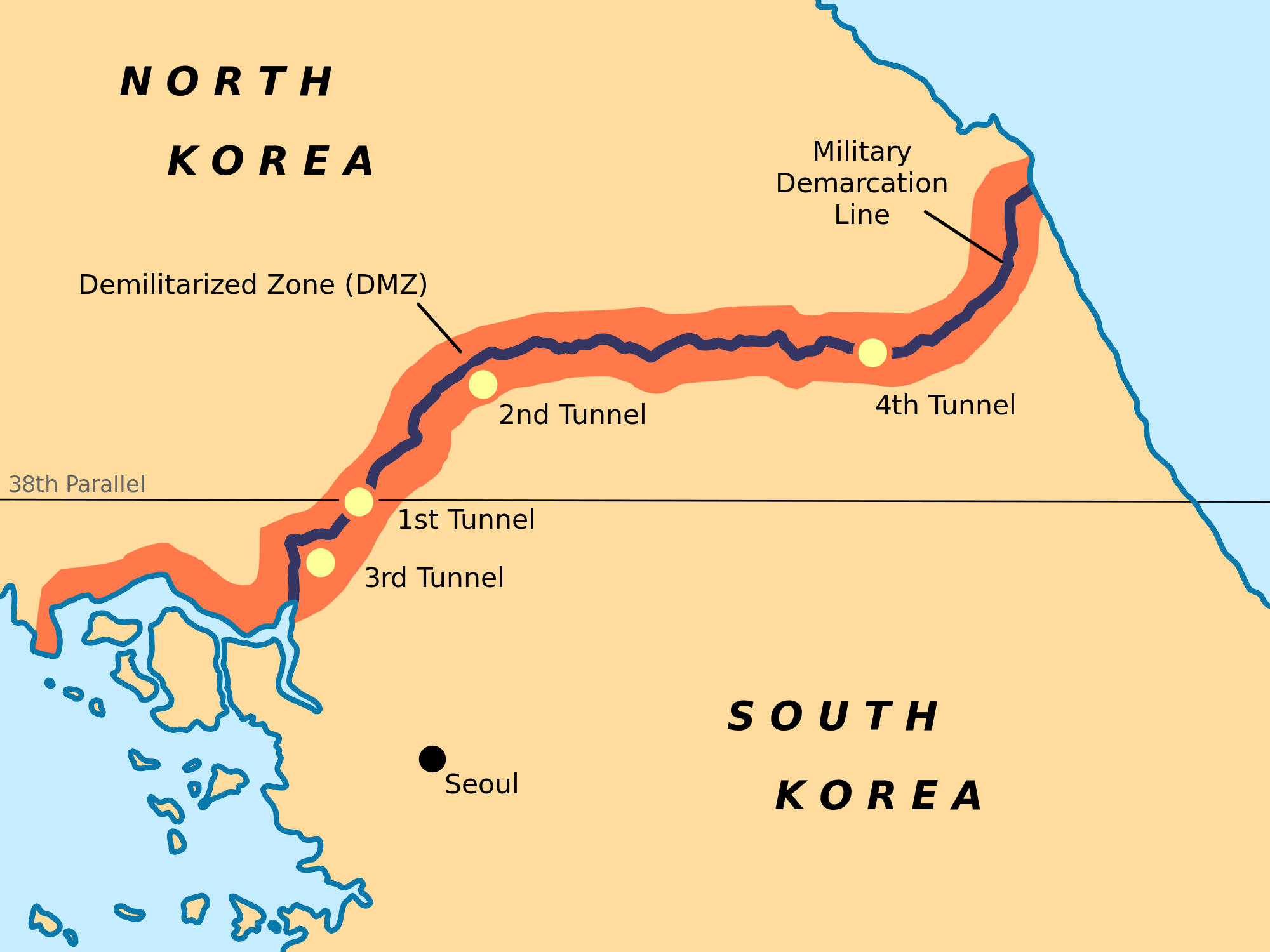
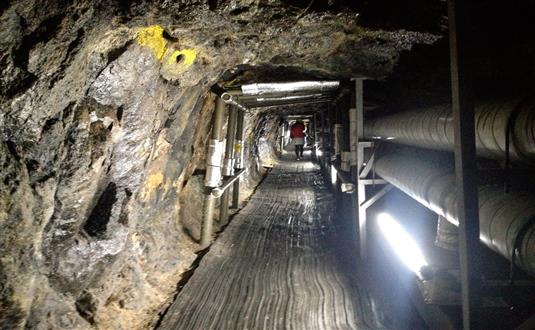
The Dora Observatory gives good views into North Korea: Kaesong City (or Propaganda City where no one lives), Kaesong Industrial Park (employs cheap N Korean labour in S Korean industries), and a huge 160m tall flagpole with a 31x16m flag weighing 700 pounds requiring a stiff breeze to unfurl it. The Dorsain Train Station, finished in 2002, is a huge ultramodern station but has not seen a train pass through since 2008 after a diplomatic incident. A speech given by George W Bush was given here on the opening. The highlight of the tour is the Joint Security Area (Panmunjeom) situated 2kms inside the DMZ right at the border. Here are the UN buildings used for meetings between the two countries with a small meeting table straddling the border. One can actually safely go 5m into N Korea here. The unusually tall South Korean soldiers stand guard in a threatening taekwondo stance, an essential photo-op.
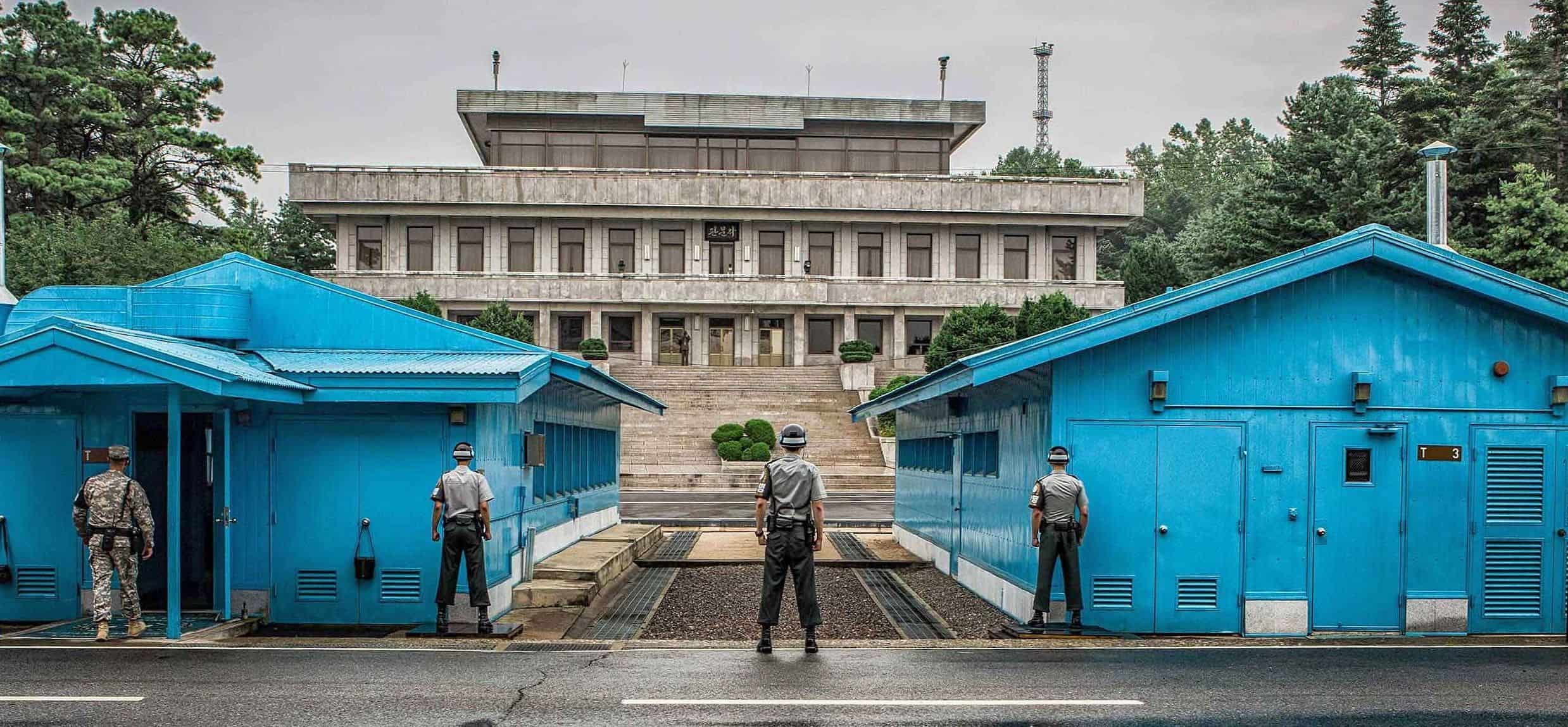
We were lucky and the N Korea border guards of the KPA (Korean Peoples Army) arrived while we were in the meeting room as there was a tour going on in their side. Pictures from a few feet away were possible. A S Korean town with rice paddies everywhere extends right to the border area surrounding the JSA (These were the original farmers of the area. It has a 100m tall flag pole). It was a very worthwhile trip.
Several incidents have occurred across the border over the years, but the most interesting was the axe murder. A poplar tree obscured the view between two observation posts at the end of the Bridge of No Return. S Koreans went to trim branches, were attacked by KPA soldiers and two were killed with axes. This eventually resulted in Operation Paul Bunyan, a major military event (the US Navy went on full battle readiness) to cut down the tree completely.
Day 2.
The Myeong-Dong area is north of the river and has several minor tourist attractions. I hiked up Mount Namsan for panoramic views of this huge metropolis in all directions.
Atop the mountain is the North Seoul Tower and millions of padlocks covering the fences a foot deep signifying the love between young Koreans.


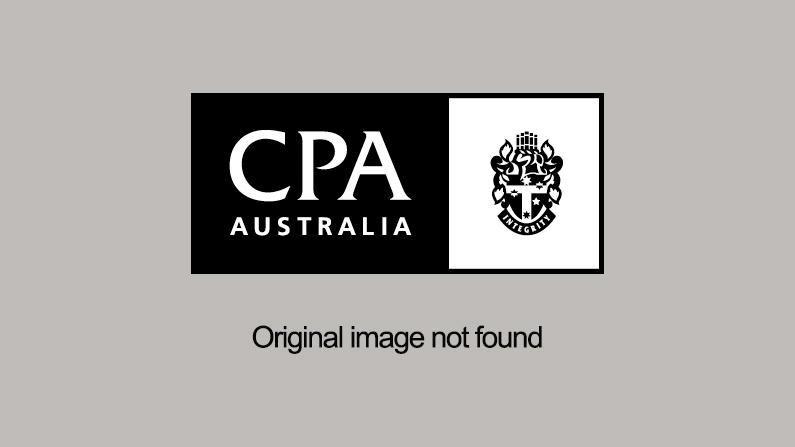
Several parts of the heavily reconstructed 18.6km Seoul Fortress Wall can be seen on the mountain. Shuttle buses, cable cars and two trails go up the mountain. Koreans are decked out in the latest mountain gear for the minor walking.
Traditional Korean villages featuring yangham or traditional houses are very common and popular tourist attraction. Namsangol Hanok Village is at the bottom of the trail off the mountain. It was so perfect in its sterile reconstruction (ie very Korean), that it looked brand new. Myeong-dong Catholic Cathedral, built in 1898, has housed and now memorializes martyrs and activists during military rule. City Hall, completed in 2013, looks like a tsunami of glass and steel, a cresting wave that provides shade. Inside is the largest living wall on earth, 7 stories of 14 kinds of plants. Deoksugung is one of the palaces, but there is little interesting other than the picturesque changing of the guards (a band, guys carrying huge banners and of course the guards, all dressed in outrageous costumes with crazy hats. The big crowds pose for pictures with the guards). Sungnyemun is an iconic huge wood and stone gate standing on an island amid major roads. I finished off a long walking day with the National Museum of Korea, another museum but in a grand, marble-lined modernist building.
Day 3
This was palace day with three of them Unesco World Heritage Sites. When the Ming dynasty of China overthrew the Mongols in the 1300s, Seoul became the capital of Korea with the start of the Joeson dynasty in 1392, when the population of the area was 100,000 (600 years later there are 24 million in the wider metro area). In 1592, Japan invaded, looting and destroying everything. All the temples were burned down but were reconstructed after the Japanese were defeated in 1597.
Japan gained control of Korea again in 1905 and made it a colony in 1910 and again all Korean culture was destroyed, temples burned and destroyed. After WW II, in 1945, the Japanese were finally expelled. Virtually all cultural monuments have been rebuilt since then, many not finished until the 1990s and some rebuilding still ongoing today.
As a result, all the “old stuff” in Korea looks brand new. Everything is perfectly reconstructed and nothing looks old, rebuilt in a Korean perfectionist way. That goes for all the temples and Unesco sites I visited. They are all a little disappointing. No buildings can be entered and one is always looking in from the front door. Most of the temples can only be visited on a guided tour in English so pay attention to the times listed in Lonely Planet. The tours are necessary as signage is infrequent and brief. One would get little out of the sterile visits without them. All have the same plan with a main palace building where kings were crowned, met foreign envoys and conducted affairs of state. Another building held banquets. All the living quarters of the kings, his wives, concubines and eunuchs surrounded these buildings. The crown prince’s palace was usually in the east of each compound, where the rising sun is. Large stone courtyards front the buildings with a 3 lane raised walkway leading to the entrances, the centre raised lane was for the king only.
Gyengbokgung (Unesco WHS) was the main palace of the Josean dynasty built in 1392. After it was destroyed 1592, it was unoccupied for 270 years. Also in the grounds is the excellent Folk Museum of Korea with informative displays on every day life – birth, education, marriage, work and funeral customs. I didn’t go to the National Palace Museum of Korea in the same grounds.
Changdeokgung (Unesco WHS) was a secondary palace to Gyengbokgung. It became the primary royal residence after the Japanese invasion of 1592 until 1872. A separate tour goes to the Secret Garden which I missed as all plantings would be in their winter, leafless stage.
Changgyeonggung was a palace built next door for the dowager queens in 1484 when Changdeokgung became overcrowded. When the Japanese gained control in 1910, everything was destroyed and the palace converted to a zoo and botanical gardens. All that has been removed, the palaces rebuilt and the ground converted to a lovely park with trees, ponds and a green house (called a glass house).
Jongmyo (Unesco WHS) was where funeral rites were held to deal with the spirits of the dead royalty. The spirits are believed to reside in a special hole bored into wooden spirit tablets. The 19 most important tablets are housed in a long building with 19 doors and another 11 are next door in a similar building. The tablets are only open to be viewed by the public twice a year. Again, one only gets to see things in Korean temples from the outside of buildings. The two lane stone walkway had one lane for the spirits and one for people. The funeral ceremony to deal with the spirits was long, detailed and very ornate.
Gwanghwamun Square is a long central boulevard between traffic lanes that leads to Gyeongbokgung Palace. It has grand statues of Admiral Yi Sun-sin who defeated the Japanese in 1597 using a new type of metal-clad warship called turtle boats, and King Sejong, the founder of the Josean dynasty. Under the square is a large shopping plaza with the Kyobo Bookstore, a huge shop with a big selection of English books including Lonely Planets.
Cheong-gye-cheon is $384 million urban renewal project where a raised highway was torn down and replaced with a 5.8km stream and landscaped oasis. Crossed by lovely bridges and flanked with walkways, it is a nice respite from busy Seoul.
Day 4
The 40 odd tombs of the Josean Dynasty are Unesco World Heritage listed and scattered across Seoul. The largest and most attractive complex is Donggureung, about 20km NE of Seoul, where 7 kings and 10 queens are buried. The tombs deal with the mortal remains of the kings while Jongmyo deals with the spirits. It was a long metro and then bus ride. The tombs are all identical – a simple gate, a three lane stone walkway, a T shaped shrine building with tables for all the offerings at the funeral, a stele building, and on a small hill behind it all, the burial site. The casket is placed in elaborate stone structures which are buried under an earthen mound which is surrounded by stone railings, statues of civil servants and animals and then surrounded by a low stone wall.
The entire area is closely mowed grass, now in winter yellow. Fences at the back of the shrine prevent you from ascending the small hill to see the actual burial site and because they are significantly raised, you get no idea what they actually look like (again this is a very irritating part of Korean cultural sites). I broke many rules here, and as I was the only one in the huge park, I ascended one of the mounds, had a good look around and then went cross-country (again not allowed) to see several more. Even the leaves in the surrounding forests had been raked.
Donggureung is in a beautiful, tranquil, rural forested area. Lovely walled creeks flow through the area. Each king along with his queen or queens (only one site here has 3 burial mounds with 2 queens) has his own site separated by forest and accessed by a separate road.

The mound is just visible at the very back on top of the hill.
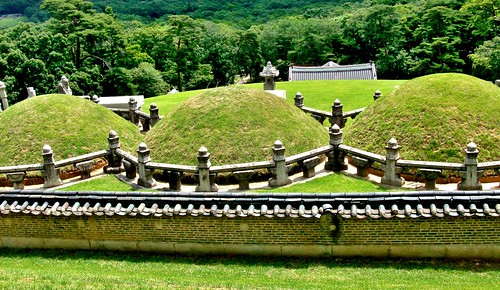
It was a lovely quiet morning. I feel like I am the only one who has ever really seen it (other than the workmen who maintain the sites). Koreans never break rules and would have been horrified to see what I had done.
SUWON (pop 1.7 million), 48km south of Seoul, became the capital of Korea when it was moved here by King Jeongjo, the 22nd Joseon dynasty ruler in 1794. He built Hwaseong (Unesco World Heritage listed), a palace surrounded by a 5.7km fortress wall. Amazingly, he died when it was just completed and power remained in Seoul. Like everything else, it was destroyed and has now been carefully reconstructed (finished in 2012) in the perfect Korean way so that it too looks brand new. From the South Gate (Paldalmun) I walked 143m up the hill to an observation point with a command post, large bell (costs 1000 won to ring), and tower. One can then walk along the wall for the whole way with its watchtowers, command posts, sentry posts, beacon towers (used fires to signal emergency situations and a series of them are all over Korea), turrets, observation towers, secret gates, pavilions, crossbow platforms, gate guard platforms, and a floodgate. It takes about 2 hours to walk the wall that now encircles a large part of the modern city.

Suwon is easily reached on the Seoul Metro with a 10 minute bus to Hwaseong. One can access the wall low down, walk around and ascend the hill only once, then descend to the palace area to see it at the end. It was Saturday when I visited and an extensive martial arts display was performed with guards in full traditional armour.
Today was a lot of metro and bus travel to see these two Unesco sites, but they were well worth it. This may be a record for me with 5 Unesco sites in two days.
I stayed at Dustin Guesthouse ($15/night for a dorm room), about 100m from the Hongik University Metro station and near central Seoul. This university is a liberal arts school and the neighbourhood is a mecca of restaurants, shops, nightclubs and street food stalls. Korean food is exceptionally good. I like it more than any other cuisine I have experienced so far this winter in SE Asia (honestly I have not liked the food very much except in Thailand and have looked for Western food whenever I could). It has been very cold in Seoul – freezing or colder every day. It even briefly snowed. I felt foolish carrying a down jacket, light fleece top, toque and all sorts of warm clothes throughout SE Asia, but am now very thankful to have all that stuff.
Seoul has an extensive, and very complex metro with 20+ lines and over a thousand stations. You can often get to your destination several different ways and transfers can entail long underground walks and going up and down many stairs and escalators. Try to avoid Seoul Station and Gonacheok Stations to make transfers – I became hopelessly lost every time I tried. Otherwise, like most subway stations throughout the world, it is marvel of construction and basically easy to navigate with all the colour coded signage. It is very cheap with even the longest journeys costing less than $1.50.
Some observations. Koreans never wear hats (except the elderly), gloves (even when it is below zero), or sunglasses. The women dress very fashionably, wear a lot of makeup, many have dyed their hair red so have black roots, and hold hands or lock arms with other women when out walking. Men never go bald, don’t need to shave often, never have facial hair, and always have short hair without sideburns. Cars are new and either Hyundais or Kias. They are extremely law-abiding – never jay-walk or walk across a red light even on tiny streets without a car in sight.
S Korea is the plastic surgery capital of the world with one-third of women in Seoul have had up to 10 procedures. Often it starts as early as middle school. The most common procedures are the epicanthic folds producing wider eyes, and mandible surgery to produce a less square jaw. The procedures are NOT to look more “western”. They are often very discreet changes resulting in many small procedures. A reality TV show “Back to My Face” details people who have their surgery ‘undone’ which is more difficult than doing it originally.
I have had some very frustrating days. On a Sunday, I wanted to go to Japan Airlines to purchase my Japan Rail Pass (which can only be done outside Japan) and cancel my flight from Bangkok to Tokyo as I was going to be in Tokyo not Bangkok. I looked all over for the office as I thought I knew where it was and spent hours before finally finding a tourist information desk and found out it was closed on Sunday. I then went to the wrong art museum and saw a poor exhibit. I then went to a Buddhist Expo hoping to see some nice art but it was in actuality a trade show with no art. The Coex Aquarium was next on the list. Supposedly the best aquarium in Seoul, it was poor. Maybe it was because it was packed with families and little kids, but it was more like an amusement park.
The next AM I was up early to go to Japan Air. They would only sell me a Japan Rail Pass if I paid in Japanese yen in cash. I eventually bought it through a travel agency with a 4% credit card surcharge. They also could not cancel my flight – cancelling one leg of any flight cancels both flights! My only option was to cancel both legs and buy a new ticket to Vancouver or fly to Bangkok, and return to Tokyo the same day to get both legs. Flying to Bangkok cost $300 less so I guess I will waste a day. Amazing! And I thought I was being so clever by leaving SE Asia to see Taiwan, Korea and Japan – a $500 mistake. However, my JR pass will run out before the flight home and I will probably save $500 by spending some days in Thailand after Japan.
I had originally planned on hiking and seeing the few other Unesco sites on the mainland peninsula, but as it has been so cold and the mountains basically inaccessible because of snow, and as I am tired to seeing perfectly restored Korean history, I flew to JEJU ISLAND, 140kms south of the mainland. Jeju has been voted onto the 7 Natural Wonders of the World list (I have criticized this list before as whole countries voted for their favourites, leaving out most of the original wonders). Jeju-si (pop 420,000) is the main city on the north coast.
Jeju is a volcanic island formed 1.8 million years ago with 1980m Mt Hallasan, the highest mountain in Korea, in the centre. Besides Hallesan there are over 300 parasitic cones spread over the island. It is 73x31km in size with a 181km long ring road following the coast. At 33 degrees north, it has all environments from tropical to polar on the top of the Mt Hallasan. It has not been volcanically active for 5000 years. Kublai Khan invaded it in the 1300s after conquering the entire peninsula.
It has been declared a Unesco World Heritage Biosphere zone with three sites included in the listing. 1. The Geomunoreum lava tube system consists of 5 tubes with only Manjanggul Lava Tube accessible to the public. It is 7.4km long and huge – 18m wide and 23m high at is biggest. It is possible to walk one kilometre of the tube and it is amazing with lava flow lines, lava rafts and domes, lava shelves, benches and balconies, and a 7.6m lava column.


2. Seongsan Ilchulbong is a 182m high volcanic tuff cone on the east coast. Formed 5,000 years ago by hydroeruptions, it has a large crater on top. Great views of the coast can be had from the top.


A small black sand cove has women divers who free dive for marine animals next to Ilchulbong.
3. Mt. Hallasan has 5 trails with two accessing the top. I had planned on climbing it but it has been raining, windy and cold, and a lot of snow on top.
I stayed on Jeju for four nights, spending some time resting after my hectic 5 months traveling so far. With my Japan Rail Pass lasting 21 days, I have been planning how to see as much of Japan as possible and hope to get almost everywhere. I flew to Busan on the southeast mainland and took a ferry to Fukuoka, on the north coast of Kyushu.